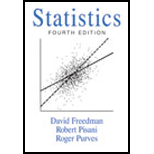
Obtain the chance that between 9% and 11% of the sample families will not own cars.
Answer to Problem 20SRE
The chance that between 9% and 11% of the sample families will not own carsis 0.8064.
Explanation of Solution
Calculation:
Based on the given information, it is clear that the population size is 25,000. 10% of them have no cars. The opinion survey includes the simple random sample of 1,500.
The box should contain 25,000, which represents the population of 25,000 people.
Let 1 represent a person who does not have a car and 0 represent a person who has a car.
In this case, the researcher is interested in drawing 1,500 tickets from a box containing 90% of populations containing 22,200 zeros
The number of draws is 1500.
Expected value of the box:
Standard deviation of the box:
Expected value of sum:
Standard error of the sum:
Expected value of the percentage:
Standard error of the percentage:
The known values are given below:
The formula for z-score is as follows:
The z-score is obtained as given below:
At
At
The chance that between 9% and 11% of the sample families will not own carsis given below:
The value corresponding to
Remaining calculation:
Therefore, the chance that between 9% and 11% of the sample families will not own cars is 0.8064.
Want to see more full solutions like this?
Chapter 29 Solutions
Statistics
 MATLAB: An Introduction with ApplicationsStatisticsISBN:9781119256830Author:Amos GilatPublisher:John Wiley & Sons Inc
MATLAB: An Introduction with ApplicationsStatisticsISBN:9781119256830Author:Amos GilatPublisher:John Wiley & Sons Inc Probability and Statistics for Engineering and th...StatisticsISBN:9781305251809Author:Jay L. DevorePublisher:Cengage Learning
Probability and Statistics for Engineering and th...StatisticsISBN:9781305251809Author:Jay L. DevorePublisher:Cengage Learning Statistics for The Behavioral Sciences (MindTap C...StatisticsISBN:9781305504912Author:Frederick J Gravetter, Larry B. WallnauPublisher:Cengage Learning
Statistics for The Behavioral Sciences (MindTap C...StatisticsISBN:9781305504912Author:Frederick J Gravetter, Larry B. WallnauPublisher:Cengage Learning Elementary Statistics: Picturing the World (7th E...StatisticsISBN:9780134683416Author:Ron Larson, Betsy FarberPublisher:PEARSON
Elementary Statistics: Picturing the World (7th E...StatisticsISBN:9780134683416Author:Ron Larson, Betsy FarberPublisher:PEARSON The Basic Practice of StatisticsStatisticsISBN:9781319042578Author:David S. Moore, William I. Notz, Michael A. FlignerPublisher:W. H. Freeman
The Basic Practice of StatisticsStatisticsISBN:9781319042578Author:David S. Moore, William I. Notz, Michael A. FlignerPublisher:W. H. Freeman Introduction to the Practice of StatisticsStatisticsISBN:9781319013387Author:David S. Moore, George P. McCabe, Bruce A. CraigPublisher:W. H. Freeman
Introduction to the Practice of StatisticsStatisticsISBN:9781319013387Author:David S. Moore, George P. McCabe, Bruce A. CraigPublisher:W. H. Freeman





